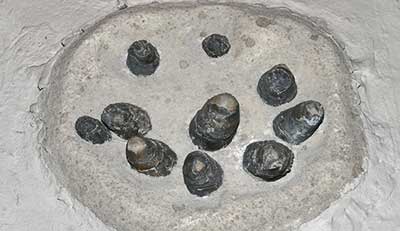Troödon
(TROO-oh-don)
| Quick Facts | |
|---|---|
| Name Meaning: | Wounding Tooth |
| Distribution: | Northwestern America (Alaska, Alberta, Wyoming) |
| Time Period: | Late Cretaceous, 70 Ma |
| Length: | 6.5 ft (2 m) |
| Weight: | 100 lbs |
| Diet: | Carnivore |
| Linnaean Classification | |
| Kingdom: | Animalia |
| Phylum: | Chordata |
| Class: | Reptilia |
| Superorder: | Dinosauria |
| Order: | Saurischia |
| Suborder: | Theropoda |
| Family: | Troodontidae |
| Genus: | Troödon |
| Cladistic Classification | |
| |

History
The Troödon was discovered in 1855 and named a year later by paleontologist Joseph Leidy. Because of some of its teeth it was first classified as a herbivorous dinosaur. Later it was determined that, although the teeth were similar to those of herbivores, the remaining teeth and other feature, such as its claws, were more likely used for carnivorous purposes. In 1969 a more complete skeleton was discovered, and described by Dale Russell. Russell later proposed that the Troödon was extremely more advanced and intelligent than other dinosaurs and had it survived the Great Extinction it could have become a "Dinosauroid" an intelligent dinosaur, human in shape with a human-sized brain and extreme intelligence. This theory has been generally disregarded by paleontologists as being overly human. However, it remains an interesting theory for speculation.Description
The Troödon was a small bird-like dinosaur with very acute vision. It had hands that could grasp objects, and large hooked claws at the end of its fingers. The arms were folded much like the wings of modern birds. Its legs were long and slender with a claw at the end of its three toes. The eyes faced forward, and could achieve binocular vision giving it excellent eye-sight. The teeth were shaped like small knives and several teeth were similar to those of herbivores. Its head contained a brain bigger than those of most dinosaurs.Lifestyle
The Troödon was probably a hunter of small mammals, although it could have taken slightly larger prey. It was an extremely fast runner. The teeth indicate that it could also have been an omnivore chewing on plants as well, although there is more evidence to suggest that it ate carnivorously. The Troödon would lay large nests of about 15 to 25 eggs. Due to certain similarities between the Troödon and some modern birds it is likely that the male would brood the eggs instead of the female. Once hatched the baby dinosaurs were already well-developed and would soon move on. Baby Troödon would reach adult size in 5 years or less.
ScienceViews Writer: Jason Hamilton.
Copyright © 2005-2010 Calvin & Rosanna Hamilton. All rights reserved.